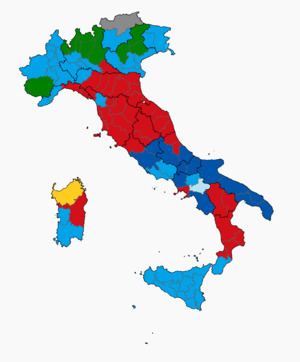27 March 1994 1996 → 366 (H)
155 (S) 213 (H)
122 (S) 16,585,516 13,308,244 Start date March 27, 1994 | Turnout 86.3% 213 (H)
122 (S) 46 (H)
31 (S) 13,308,244 6,098,986 | |
 | ||
Winner Silvio Berlusconi | ||
A snap national general election was held in Italy on March 27, 1994 to elect members of the Chamber of Deputies and the Senate. Silvio Berlusconi's centre-right alliance won a large majority in the Chamber, but just missed winning a majority in the Senate. The Italian People's Party, the renamed Christian Democrats, which had dominated Italian politics for almost half a century, was decimated. It took only 29 seats versus 206 for the DC two years earlier-easily the worst defeat a sitting government in Italy has ever suffered, and one of the worst ever suffered by a Western European governing party.
Contents
New electoral system
A new electoral system was introduced in these elections, after the abolition of the proportional representation established after the end of World War II, by a referendum in 1993.
The new intricate electoral system of Italy, nicknamed the Mattarellum (after Sergio Mattarella, who was the official proponent), provided 75% of the seats in the Chamber of Deputies (the Lower House) as elected by plurality voting system, whereas the remaining 25% was assigned by proportional representation, with a minimum threshold of 4%. The method associated with the Senate was even more complicated: 75% of the seats by uninominal method, and 25% by a special proportional method that in practice assigned the remaining seats to minority parties.
Historical background
In 1992, the five pro-western governing parties, Christian Democracy, the Italian Socialist Party, the Italian Social-Democratic Party, the Italian Republican Party and the Italian Liberal Party, lost much of their electoral strength almost overnight due to a large number of judicial investigations concerning the financial corruption of many of their foremost members. This led to a general expectation that upcoming elections would be won by the Democratic Party of the Left, the heirs to the former Italian Communist Party, and their Alliance of Progressives coalition unless there was an alternative.
On 26 January 1994, the media magnate Silvio Berlusconi announced his decision to enter politics, ("enter the field", in his own words) presenting his own political party, Forza Italia, on a platform focused on defeating the Communists. His political aim was to convince the voters of the Pentapartito, (i.e. the usual five governing parties) who were shocked and confused by Mani Pulite scandals, that Forza Italia offered both novelty and the continuation of the pro-western free market policies followed by Italy since the end of the 2nd World War. Shortly after he decided to enter the political arena, investigators into the Mani Pulite affair were said to be close to issuing warrants for the arrest of Berlusconi and senior executives of his business group. During his years of political career Berlusconi has repeatedly stated that the Mani Pulite investigations were led by communist prosecutors who wanted to establish a soviet-style government in Italy.
In order to win the election Berlusconi formed two separate electoral alliances: Pole of Freedoms (Polo delle Libertà) with the Northern League (Lega Nord) in northern Italian districts, and another, the Pole of Good Government (Polo del Buon Governo), with the post-fascist National Alliance (Alleanza Nazionale; heir to the Italian Social Movement) in central and southern regions. In a shrewd pragmatic move, he did not ally with the latter in the North because the League disliked them. As a result, Forza Italia was allied with two parties that were not allied with each other.
Berlusconi launched a massive campaign of electoral advertisements on his three TV networks. He subsequently won the elections, with Forza Italia garnering 21% of the popular vote, the highest percentage of any single party. One of the most significant promises that he made in order to secure victory was that his government would create "one million more jobs".
On the other side, the center-left Alliance of Progressive led by Achille Occhetto, also called the Joyful War Machine, was composed by the two party born from the dissolution of the Italian Communist Party: the Democratic Party of the Left and Communist Refoundation Party. Since the alliance was sure of victory, based his campaign accusing the communicative power of Silvio Berlusconi.
Results
On election day, Berlusconi's coalition won a decisive victory over Occhetto's one, becoming the first center-right coalition to win general election since the Second World War. In the popular vote, Berlusconi's coalition outpolled the Alliance of Progressive by over 5.1 million votes. Pole of Freedoms won in the main regions of Italy: in the North the strongest parties were the regionalist Lega Nord and Forza Italia, which was able to win in all province of Sicily, while in the South National Alliance received more votes. Alliance of Progressive reconfirmed itself in the ex-communist regions in the Center and in the South.
Instead of it had done in the Chamber, Pole of Freedoms failed in winning a majority in the Senate. Although, the Berlusconi I Cabinet obtained a vote of confidence also in the Senate, thanks to the defection of four PPI senators (Vittorio Cecchi Gori, Stefano Cusumano, Luigi Grillo and Tomaso Zanoletti), who decided not to participate in the vote.
The vote of the Senators for life was not decisive, as three (Gianni Agnelli, Francesco Cossiga and Giovanni Leone) voted in favour of the government, three were absent (Carlo Bo, Norberto Bobbio and Amintore Fanfani) and five voted against (Giulio Andreotti, Francesco De Martino, Giovanni Spadolini and Paolo Emilio Taviani and Leo Valiani).
The Senate finally gave Berlusconi 159 votes in favour and 153 against.
Close regions
Regions where coalition's margin of victory < 5% for the Chamber
- Molise, 1.5%
- Campania, 2.1%
- Lazio, 2.5%
- Liguria, 3.6%
